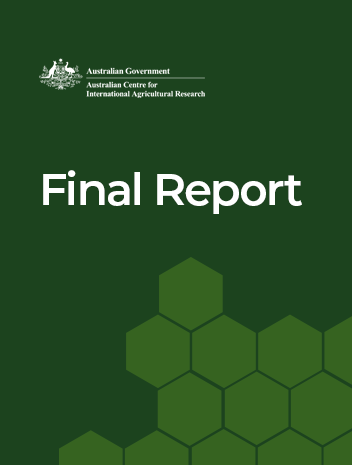- HomeHome
-
About ACIAR
- Our work
- Our people
-
Corporate information
- ACIAR Audit Committee
- Commission for International Agricultural Research
- Policy Advisory Council
- Agency reviews
- Executive remuneration disclosure
- Freedom of information (FOI)
- Gifts and benefits register
- Information publication scheme
- List of new agency files
- Contracts
- Legal services expenditure
- Privacy impact assessment register
- Commonwealth Child Safe Framework
- Benefits to Australia
- Careers
- 40 years of ACIAR
-
What we do
- Programs
- Cross-cutting areas
- Resources
- Where we work
-
Funding
- Research projects
- Fellowships
-
Scholarships
- John Allwright FellowshipScholarships to study in Australia for ACIAR partner country scientists to have Australian postgraduate qualifications
- ACIAR Pacific Agriculture Scholarships and Support and Climate Resilience Program
- Alumni Research Support Facility
- Publications
- News and Outreach
Project final report
Integrated disease management of sugarcane streak mosaic in Indonesia - final report
Date released
06 September 2019
ISBN
978-1-925747-85-0
Publication Code
HORT/ 2012/ 083
Overview
The project aimed to manage sugarcane streak mosaic virus (SCSMV), a widespread disease that affects the Javan sugarcane industry.
Sugarcane is an important agricultural crop in Indonesia and contributes Rupiah 11,500 billion (A$1.57 billion) to the Indonesian rural economy. More than 140,000 farmers grow sugarcane, and 1.3 million workers work in associated industries. Almost all sugarcane farmers are small-holders who rely on sugarcane as a cash crop. Productivity has declined over the last 40 years. Pests and diseases contribute to this production slide, and stem borers affect crop yields in Java.
The disease also affects sugarcane in expanding areas, particularly West Papua. A survey of 931 crops in Java identified and implicated the virus in nearly 80% of crops displaying visual mosaic-type symptoms.
Many commercial varieties are susceptible to the disease, and only two popular varieties are resistant. Commercial cane farmers have few options for disease control.
Disease-free nursery material is a key strategy needing strong implementation. Many facets of the disease need researching so that an effective integrated disease management strategy can be implemented in Java, Sumatra, Sulawesi, Sumba and West Papua. That strategy is likely to include disease-free planting material, resistant varieties and the termination of heavily-diseased, susceptible crops.
The project assessed the importance of sugarcane streak mosaic virus; determined the potential for escalation; identified resistant varieties of sugarcane; and developed management tools for nursery and farm level production.



